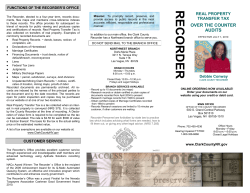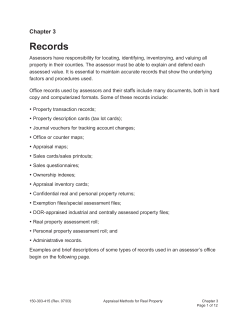
Adding or Changing Names on Property COMPLETING AND RECORDING DEEDS
Sacramento County Public Law Library & Civil Self-Help Center 609 9th Street Sacramento, CA 95814 (916) 874-6012 www.saclaw.org COMPLETING AND RECORDING DEEDS Adding or Changing Names on Property Disclaimer: This guide is intended as general information only. Your situation may have factors requiring different procedures or forms. The information and instructions are provided for use in Sacramento County. Please keep in mind that each county may have different requirements. If you need further assistance, consult a lawyer. FORMS Deeds must be in a format that the County Recorder’s Office will accept. Forms may be downloaded from these links: Grant Deed (PDF) bit.ly/saclaw-grant-deed Quitclaim Deed (PDF) bit.ly/saclaw-quitclaim-deed BACKGROUND Any time you make a change to the ownership of real estate, you must record a deed with the County Recorder. This Step-by-Step guide outlines the requirements and provides a sample Grant Deed with instructions. California uses only two types of deeds for ownership changes: the “grant deed” and the “quitclaim deed.” You may see deeds called things like “warranty deeds” or “interspousal deeds,” but technically they are sub-categories of grant or quitclaim deeds. The grant deed is used when a person who is on the current deed transfers ownership or adds a new owner. The transferor (donor or seller) warrants (promises) that all rights are being transferred. The quitclaim deed is used when someone, who may or may not be named on the deed, gives up their interests in favor of another Warning – Adding Names Anyone you add onto your deed immediately becomes an equal co-owner. You cannot remove them without their signature. Because they are legal co-owners: You need their approval and signatures to sell or refinance the entire property. If they get into debt, creditors may put liens on the house, or even foreclose on it. They can give away or sell their share. You could end up co-owners with in-laws (or exin-laws) or strangers. They can mortgage their share. Your home could end up saddled with a home equity loan you didn't agree to. Disagreements over control can lead to family rifts and expensive, bitter lawsuits. In addition, Your property taxes may go up. Your Medi-Cal benefits may be affected. You may have to file a gift tax return this year, and your lifetime gift/estate tax credit may be reduced. If you add your heirs, they may eventually pay higher capital gains taxes than if they had inherited the property. If you have a mortgage, it may become due if you add an owner, putting you in default. Get written permission from the lender first. person. The transferors are not warranting anything other than that they are giving up any existing or potential rights. A quitclaim deed is commonly used in divorces, when one spouse gives up any potential community property interest. See the “Grant Deed/Quitclaim Deed” chart on page 6 for more information. Note: Do not use a “deed of trust” or “trust deed.” A deed of trust is never used to transfer ownership (not even to a trust!). It is used to create a mortgage. For more information on Deeds of Trust, see the Step-by-Step guide on our website at www.saclaw.org/pages/deed-of-trust.aspx. Step by Step Instructions STEP 1: LOCATE THE CURRENT DEED FOR THE PROPERTY You will need to copy the legal description of the property and current ownership information onto the new deed exactly. If you do not have a copy of the current deed, you can purchase one from the Recorder’s Office. In Sacramento, this costs $1 per page; most deeds are only one page long. You can contact the Sacramento office at (916) 874-6334 or visit one of the office locations (see www.ccr.saccounty.net/ for addresses and more information). STEP 2: DETERMINE WHAT TYPE OF DEED TO FILL OUT As discussed above, to transfer ownership or add someone to title, you will choose between a “grant deed” and a “quitclaim deed.” See the “Grant Deed/Quitclaim Deed” chart on page 6 for more information. STEP 3: DETERMINE HOW THE NEW OWNERS WILL TAKE TITLE There are several options for how to “take title” to the property. If more than one person is on title, the form has important effects on who can sell the property and who inherits. Common forms are “as joint tenants,” “as community property with right of survivorship” (for married couples or domestic partners), and “as a single man/woman.” See the “How to Take Title” chart on page 7 for more information. STEP 4: FILL OUT THE NEW DEED (BUT DO NOT SIGN) The deed should be filled out online and printed, typed, or neatly written in dark blue or black ink. See page 4-5 for samples. You will need the following information: Assessor’s Parcel Number (from current deed or Assessor’s office). Document Transfer Tax or exemption: Whenever property is sold, this tax is added. Some transfers are exempt. See the “Document Transfer Tax” page on page 8 for more information. Names of “grantors” (current owners as shown on current deed) with form of title, or disclaiming parties. Names of “grantees” (all new or continuing owners). Form of title the grantees will use, for grant deed. The legal description of the property. This must match the current deed exactly. You can attach the legal description as an exhibit if it is too long to fit on the page. 2 A sample completed grant deed with more detailed instructions follows. The quitclaim deed is almost identical, with one less line to fill in (the form of title). STEP 5: CURRENT OWNERS OR DISCLAIMING PARTIES SIGN THE DEED IN FRONT OF A NOTARY New owners do not need to sign. The notary will charge a fee for this service. You can find notaries at many banks, mailing services, and title companies. The Law Library maintains a list of local notaries; ask at the Reference Desk if you are interested. STEP 6: FILL OUT THE PRELIMINARY CHANGE OF OWNERSHIP REPORT (PCOR) The PCOR is required by the Assessor’s Office, but is turned in at the Recorder’s Office along with the deed. You can download a Sacramento copy at bit.ly/1kE5zNl. STEP 7: RECORD THE DEED AND FILE THE PCOR AT THE RECORDER’S OFFICE The Recorder’s Office charges a recording fee (currently $21/first page plus $3 for additional pages). Current Sacramento fees are available at the County Clerk/Recorder’s website at www.ccr.saccounty.net/Pages/Fees.aspx. The deed will be recorded the same day it is received at the Recorder’s Office. STEP 8: FILE ANY REQUIRED PROPERTY TAX REASSESSMENT EXCLUSION CLAIM IN THE ASSESSOR’S OFFICE When property changes hands, it is “reassessed” for tax purposes, often causing a sizeable increase in property tax for the new owner. Certain transfers are excluded from reassessment, including: Parent to child or child to parent (“Prop 58” exclusion) Grandparent to grandchild (but not vice versa) Transfers between spouses or registered domestic partners during marriage or as part of a property settlement or divorce Changes in method of holding title that do not change ownership interests (for instance, changing joint tenants into tenants in common) If your transfer is excluded from reassessment, you may need to file a claim with the County Assessor. For more information in Sacramento, call the Assessor’s office (916-875-0750) or visit bit.ly/1mS0KC8. FOR HELP Senior Legal Hotline Toll Free: (800) 222-1753; Sacramento County: (916) 551-2140 www.seniorlegalhotline.org/ Free legal assistance for Sacramento residents age 60 and over on almost any civil issue, including property transfers and deeds. 3 FOR MORE INFORMATION On the Web: Sacramento County Clerk-Recorder’s Office www.ccr.saccounty.net/ Sacramento County Assessor’s Office www.assessor.saccounty.net/default.htm Sacramento Press: Ask the County Law Librarian “Adding Kids to the Title on Your House” bit.ly/X0dF7c This article discusses some potential disadvantages and dangers of adding children onto your deed as a method of avoiding probate, including higher taxes and potential debt liability. At the Law Library: Deeds for California Real Estate KFC 170 .Z9 R36 This book, published by Nolo Press, a respected publisher of self-help legal books, is a guide to choosing the right kind of deed, completing the required forms, and filing them. It also discusses related legal issues such as disclosure requirements, community property issues, and tax and estate planning. It contains forms for most transfers of property. Electronic Access: From any computer (Library or home) via the Legal Information Reference Center. Instructions are available on our website at www.saclaw.org/pages/ nolo-ebooks.aspx. IF YOU HAVE QUESTIONS ABOUT THIS GUIDE, OR IF YOU NEED HELP FINDING OR USING THE MATERIALS LISTED, DON’T HESITATE TO ASK A REFERENCE LIBRARIAN. H:\public\LRG-SBS\SbSs\SBS Deeds\SBS Deeds.docx Revised 5/2014 (KF) 4 Sample for Step 4: Fill Out the New Deed See Page 8 of Guide for more information. Assessor’s Parcel No. • In the first line, enter the amount of Doc. Transfer Tax due. • If you are paying $0, put the Cal. Rev. & Tax code exempting you in the 2nd line. • If you are paying $0, explain briefly in the 3rd and 4th lines. • You (or your agent if any) sign the last line. If more than one person will own the property, enter the form of title in which the new owners will hold the property. See Page 6-7 of Guide for more information. OR: Attach the description on a separate piece of paper labeled “Attachment 1” and type or write “See Description in Attachment 1” in this space. Enter the exact legal description of the property as shown on the current deed. OR: attach the description on a separate piece of paper labeled “Attachment 1” and type or write “See Description in Attachment 1” in this space. Only current owners must sign. WAIT TO SIGN – SIGN IN FRONT OF NOTARY 5 6 Common Title Phrases Updating title after name change: Janet Smith-Jones, who acquired title under the former name of Janet Smith, new name hereby grants to Janet Smith-Jones Single person: David Jones, an unmarried man or Janet Smith, an unmarried woman prior name Married/domestic partner who owns property separate from spouse: Janet Smith-Jones, a married woman, as separate, not community property Tenants in common: Janet Smith and Robert Johnson as tenants in common Joint tenants: Janet Smith and Robert Jones as joint tenants with right of survivorship Married/domestic partners as community property: Janet Smith-Jones and David Smith-Jones, husband and wife, as community property or Janet Smith and Darla Jones, registered domestic partners, as community property Married/domestic partners as community property with right of survivorship: Janet Smith-Jones and David Smith-Jones, husband and wife, as community property with right of survivorship or Janet Smith and Darla Jones, registered domestic partners, as community property with right of survivorship Trust: Janet Smith as trustee of the Janet Smith Family Trust dated July 2, 2012 (exact name and date on trust documents) Partnership: Elm Street Books, a partnership (exact name on file as fictitious business name) or Janet Smith and Mark Baker, a partnership (names of partners) Note: in most cases, any partner can sign deeds. Corporation or LLC: Elm Street Books, Inc. or Acme Roofers, a California Limited Liability Company (exact name on documents filed with Secretary of State) Note: For corporations, the board of directors usually must approve real property transactions, and the authorized officer will sign. For LLCs, the owners (members) must approve real property transactions, and authorize a member to sign. 7 Document Transfer Tax A Document Transfer Tax must be paid whenever property is sold. Contact your County Recorder for current rates. In Sacramento County, you can find the current rate at http://www.ccr.saccounty.net/Pages/FAQ.aspx. Exemptions: Many transactions in which no money changes hands qualify for an exemption. The most common exemptions are listed below. Enter the R&T code and explanation in the Documentary Transfer Tax Box. Gift (transferring property, or adding someone to property, without compensation): Exemption (R&T Code): “R&T 11911” Explanation: “Gift.” NOTE: “compensation” is not always money. For instance, forgiving a loan, trading for other property, or providing services would be considered compensation. Living Trust (transfer from grantors into grantors’ revocable living trust): Exemption (R&T Code): “R&T 11930” Explanation: “Grantee is a Trust for the benefit of the grantors.” Name Change (confirming name change after marriage or court-ordered name change): Exemption (R&T Code): “R&T 11911” Explanation: “This conveyance confirms a change of name and the grantor and grantee are the same party.” Conveyances in dissolution of marriage: Exemption (R&T Code): “R&T 11927” Explanation: “Dissolution of marriage.” Changing Manner in Which Title is Held (e.g., transfer between individuals and partnership): Exemption (R&T Code): “R&T 11925” Explanation: “Grantors and grantees are comprised of the same parties and their proportional interest remains the same immediately following transfer.” Mortgages and Liens Exceed Fair Market Value: Exemption (R&T Code): “R&T 11911” Explanation: “Liened to full value.” Additional exemptions may be available if these do not apply. See the list of “Transfer Tax Exemptions under Revenue & Taxation Code” handout, available on the website of the Sacramento County Clerk/Recorder Department at http://www.ccr.saccounty.net/Documents/DTTexemptions.pdf. 8
© Copyright 2025


















